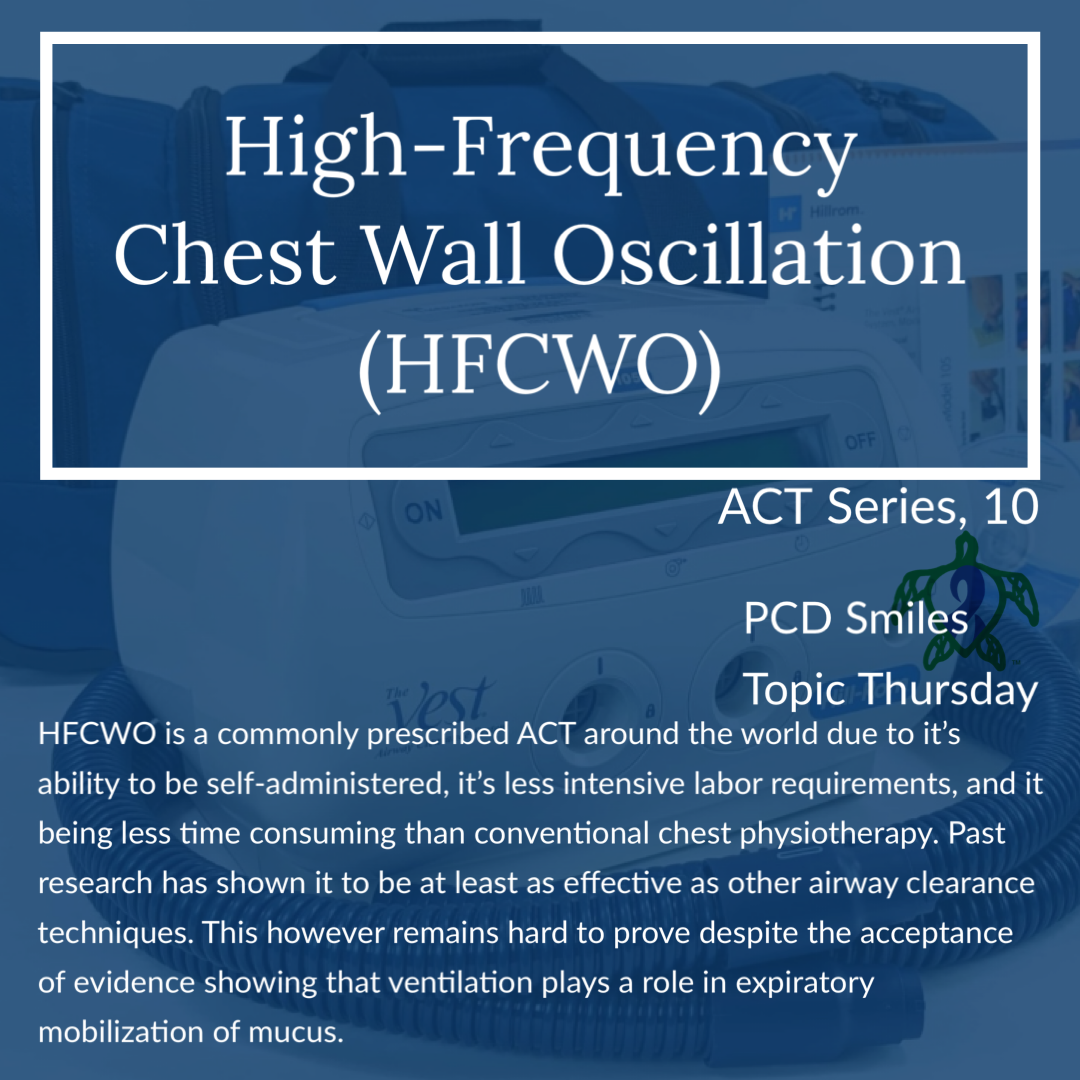The next device that we will cover in our airway clearance technique (ACT) series is high-frequency chest wall oscillation (HFCWO). HFCWO is a commonly prescribed ACT around the world due to it’s ability to be self-administered, it’s less intensive labor requirements, and it being less time consuming than conventional chest physiotherapy. Past research has shown it to be at least as effective as other airway clearance techniques. This however remains hard to prove despite the acceptance of evidence showing that ventilation plays a role in expiratory mobilization of mucus. So outside the United States HFCWO remains an experimental practice. A practice that is reserved for patients with specific medical conditions who are experiencing steep medical declines, and who’s declines have failed to level off or respond to all other forms of airway clearance. HFCWO is usually then granted to these specific patients on compassionate grounds, but not always. Most national health care systems outside the United States follow this line of reasoning, but the patient and their families are often required to pay out of pocket for the more expensive HFCWO devices like the vest airway clearance systems. One such country that allows the vest through this process is the United Kingdom (UK). Although rare, cystic fibrosis (CF) patients who are in step decline and have documentation showing that they have not responded to all other methods of airway clearance can be prescribed the vest airway clearance system in the UK. Whether or not the NHS actually pays for the machine depends on their regional authority who controls expenditures within the region.
Recent advancements in the understanding of the physiological processes of the lungs, the body’s natural airway clearance processes, and radiological imaging are now allowing researchers to use high-resolution computed typography (HRCT) or MRI as a new approach to viewing, studying, and understanding the effects of HFCWO in patients with impaired mucociliary clearance disorders like cystic fibrosis (CF) and primary ciliary dyskinesia (PCD). High-frequency chest wall oscillation works under the premise that applying high frequency oscillation directly to the patient’s chest wall will mobilize mucus and other liquids within the airways by air and liquid interactions. During HFCWO; chest compression and mechanical oscillations create rapid airflow in and out of the airways to mobilize liquids and mucus within the airways, while stimulating the cilia within the airways to move faster and do their job more efficiently and effectively. It’s extremely important to keep the airways appropriately hydrated, preform appropriate breathing exercises, cough at appropriate times, and or preform huff coughs during the entire duration of the prescribed HFCWO treatment for the treatment utilizing HFCWO to be effective. If you don’t stay hydrated, breathe right, and cough where appropriate with the proper coughing techniques then the effectiveness of HFCWO will be significantly reduced. So breathing and coughing are extremely important as is keeping airway mucus hydrated during treatments. The use of daily HFCWO has been shown to prevent pneumonia, increase oxygen saturations, and improve lung function.
Examples of HFCWO are handheld percussors, air bladder vibration vests, and percussion vests. The first HFCWO device was developed in-house to help medical facility licensed respiratory therapists decrease their workload while increasing their productivity during their scheduled shifts while serving their patients with effective airway clearance during the patient’s lung tuneup. So basically it helped respiratory therapist provide intensive airway clearance in a time efficient manner without being labor intensive to the therapist. This was first done with mechanical handheld percussion devices routinely called percussors. Within a few years most medical facilities within the United States switched to special percussors with more advanced settings and vibrations used to target specific frequencies that were found to be more effective at moving secretions within the airways. These specialized percussors replaced the use of manual percussion preformed by respiratory therapist, and were used in conjunction with postural drainage positions. Specialized percussors are still in use to this day, although less frequently, as an adjunct ACTs for more targeted airway clearance and are a prescription only device prescribed by a licensed medical professional. It’s important to note that massage guns and other massage devices are not meant to be used in place of FDA approved percussors designed specifically for mobilization of mucus and other airway fluids. Using a massage gun or other message device not designed for use in airway clearance can injure or harm the patient, the patient’s airways, the patient’s natural airway clearance, and impede the mobilization of secretions like mucus potentially leading to significant harm to the patient. Ask your clinic’s licensed respiratory therapist or your clinic’s contracted licensed respiratory therapy provider for more information on mechanical percussor devices and how they can be used to augment your current airway clearance regiment.
Another HFCWO device is the air bladder vest. The first air bladder vest was the Vest Airway Clearance System® developed in 1989 at the University of Minnesota. The original vest has undergone many names and models to what it is know as today, the Model 105® by Baxter. There is also now the SmartVest®, AffloVest® and the Lifotronic PV-100. The use of the vest system is widely misunderstood outside the United States and even within the United States by prescribers and patients alike. Most view the vest as a passive form of airway clearance, but it is not. The vest operates at different pressures and frequencies during treatments in conjunction with airway hydration, precise cough stifling, precisely timed coughing, and breathing techniques and exercises. The vest is anything but passive. This misunderstanding might be due to the lack of effective communication between the manufacturer, the manufacturer’s trainers, respiratory therapist, medical professionals, patient caregivers, and even due to pediatric to adult transition. Basically the technique gets lost in translation. Most vests can be prescribed beginning at six months of age. Most pediatric patients lack the understanding of effective coughing, stifling coughs, ability to preform breathing techniques and exercises, or even understand them. Child vest users should be instructed to breathe deeply and consistently throughout their treatment and cough when they feel a cough is needed. As the child begins to understand and is oriented to recognizing the need to cough and that it brings up mucus, they should be instructed on effectively learning to cough out the mucus instead of swallowing it. Once this is achieved they should then begin to learn to incorporate active cycle breathing into their vest session. Graduating to performing proper huff coughs and active cycle breathing techniques while their vest is running and while inhaling nebulized medications. As the patient gets more used to properly preforming these techniques while doing a vest treatment; they should move on to stifling their coughs and allowing the mucus to build and move along the airways with the vest, and only coughing during the cough pauses at every five minute interval. This increases the effectiveness of the HFCWO. Not hydrating the airways during the vest treatment, not breathing properly, and not coughing properly during a vest treatment lowers the effectiveness of the vest. The sequence of chest pressures and chest wall oscillations is extremely important to effectiveness as well. Staying at the same pressure and frequency during the entire duration of the vest treatment is less effective and inefficient than following advanced settings that changes the frequency and pressures in sequence that is aimed specifically at moving secretions from the smaller airways to the larger airways to be coughed out. And while active cycle breathing, huff coughs, and other breathing techniques and exercises can and should be performed during HFCWO treatments, PEP and or OPEP device use is not recommended at the same exact time HFCWO is performed. Using PEP and OPEP devices at the same exact time as HFCWO can cause airway injuries. However air bladder vests can be used with all postural drainage positions, though as with any ACT, inversion is no longer suggested or recommended. Patients with head or neck injuries that have not been stabilized, or those with active hemorrhage with hemodynamic instability should not use an air bladder vest. Patients with neuromuscular disorders may require adjunct therapies to enable proper coughing and clearance of their airways during use of any air bladder vest machine. Please see your clinic’s licensed respiratory therapist or your clinic’s contacted licensed respiratory therapy provider for more information and detailed custom machine settings.
The use of and freedom of being mobile while taking advantage of the airway clearance provided by vest systems has taken center stage recently in a more device oriented world. In 2017 the Monarch™ Airway Clearance System® was introduced by Hilrom, now known as Baxter. The Monarch® uses pulmonary oscillating discs that create a magnetic field whether the device is turned off or on. Due to the magnetic field the Monarch® is contraindicated in people with implanted medical devices where the device cannot be kept at least six inches away from the implanted device and or component. Devices such as but not limited to pacemakers, neurostimulators, infusion pumps, circulatory support devices, implantable cardioverter defibrillators (ICDs), and or Cochlear implants including the BAHA sound system processors when clicked into the abutments. The Monarch® is also torso size dependent and the percussion discs need to rest on the lungs. Persons with bigger breasts will not benefit from the Monarch® due to disc placement requirements. The Monarch® is also contraindicated in persons with head or neck injuries that have not been stabilized, or those with active hemorrhage with hemodynamic instability. Patients with neuromuscular disorders may require adjunct therapies to enable proper coughing and clearance of their airways during use of the Monarch®. Patients should be old enough to use proper airway hydration, coughing techniques, and proper breathing techniques and exercise while using the Monarch®.
The use of HFCWO is partially aimed at stimulating the naturally working cilia in a patient’s airway. The effectiveness of HFCWO in primary ciliary dyskinesia (PCD) remains up for debate because of the lack of naturally working cilia due to structural defects within the cilia themselves in a patient with PCD. More targeted research into HFCWO and PCD is needed to evaluate its effectiveness for PCD patients. While airway clearance techniques are widely used throughout the world; the physiological mechanisms and consequences of airway clearance techniques are mostly misunderstood in the context of the diseases that the airway clearance techniques are prescribed for. What is understood is that airway clearance techniques are intended to remove mucus from the peripheral airways to the central airways where the mucus can be expectorated or rather coughed out by the patient. This process of moving the mucus along the airways to be expectorated can last for several minutes after the treatment or rather ACT session has ended. Patients can expect to have increased voluntary and involuntary airway clearance, sometimes for several hours after the ACT session has ended. ACTs provide temporary increase in mucociliary clearance, which is why multiple ACT sessions are needed daily to be effective at helping maintain pulmonary hygiene or rather effective airway clearance. We hope that you join us next week for part eleven of our series on airway clearance techniques.
Be sure to join us next week for another Topic Thursday.
Join our Facebook group Turtle Talk Café today.
We have several ways that you can donate to PCD Smiles;
- Visit Smile E. Turtle's Amazon Wishlist
- For more information on how you can donate, please visit our "Donation" page to check out our "Do & Don't policies.
- Or sponsor a PCD Smiles cheer package today!
- To shop for your “Official” turtle care ribbon gear today, visit PCD Style or Smile E. Cove
Thank you for your consideration!
***Please speak to your respiratory therapist or your PCD medical team before commencing any new treatment. DO NOT start using a device, or technique, on this website if you have not discussed this with your PCD team first.***














